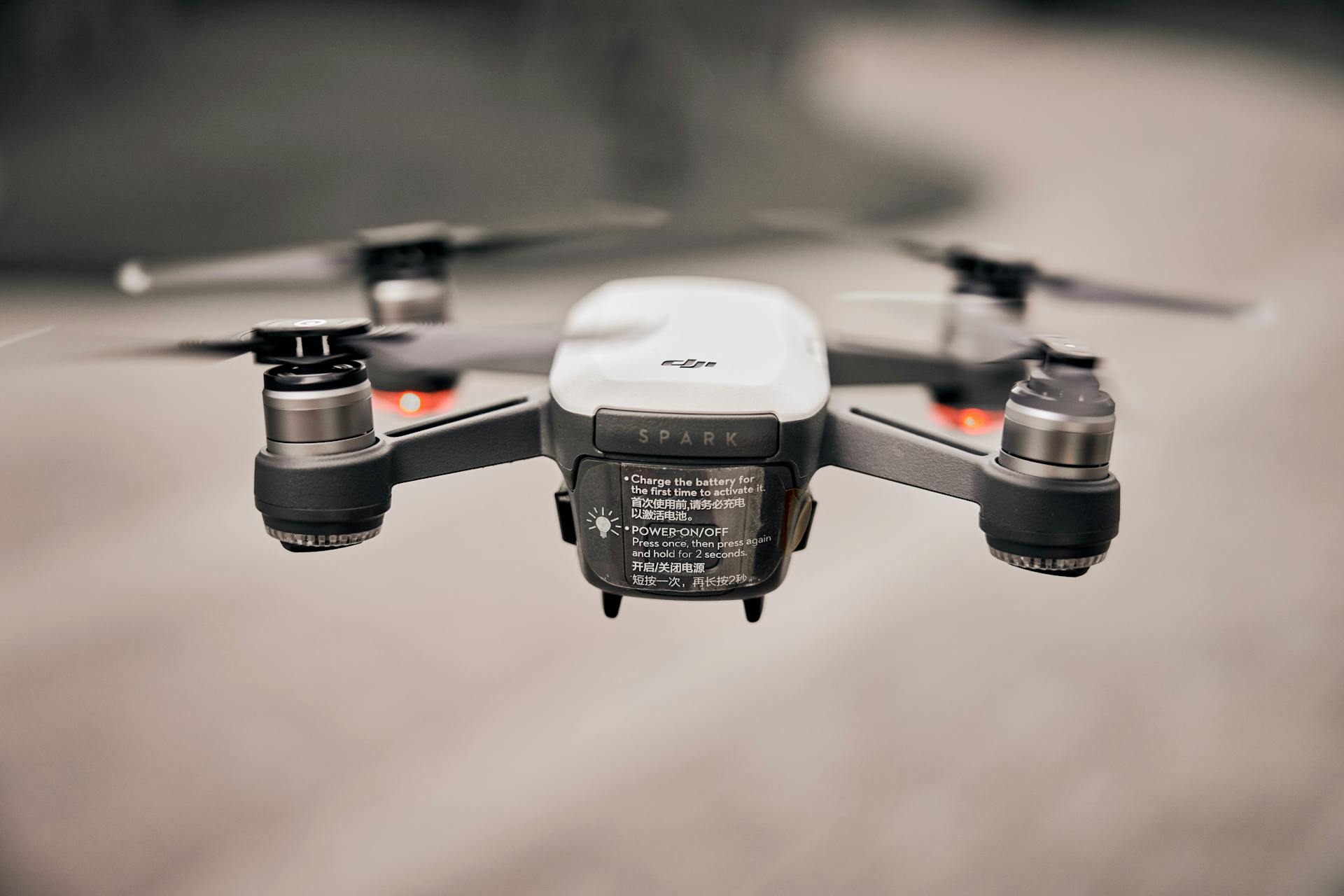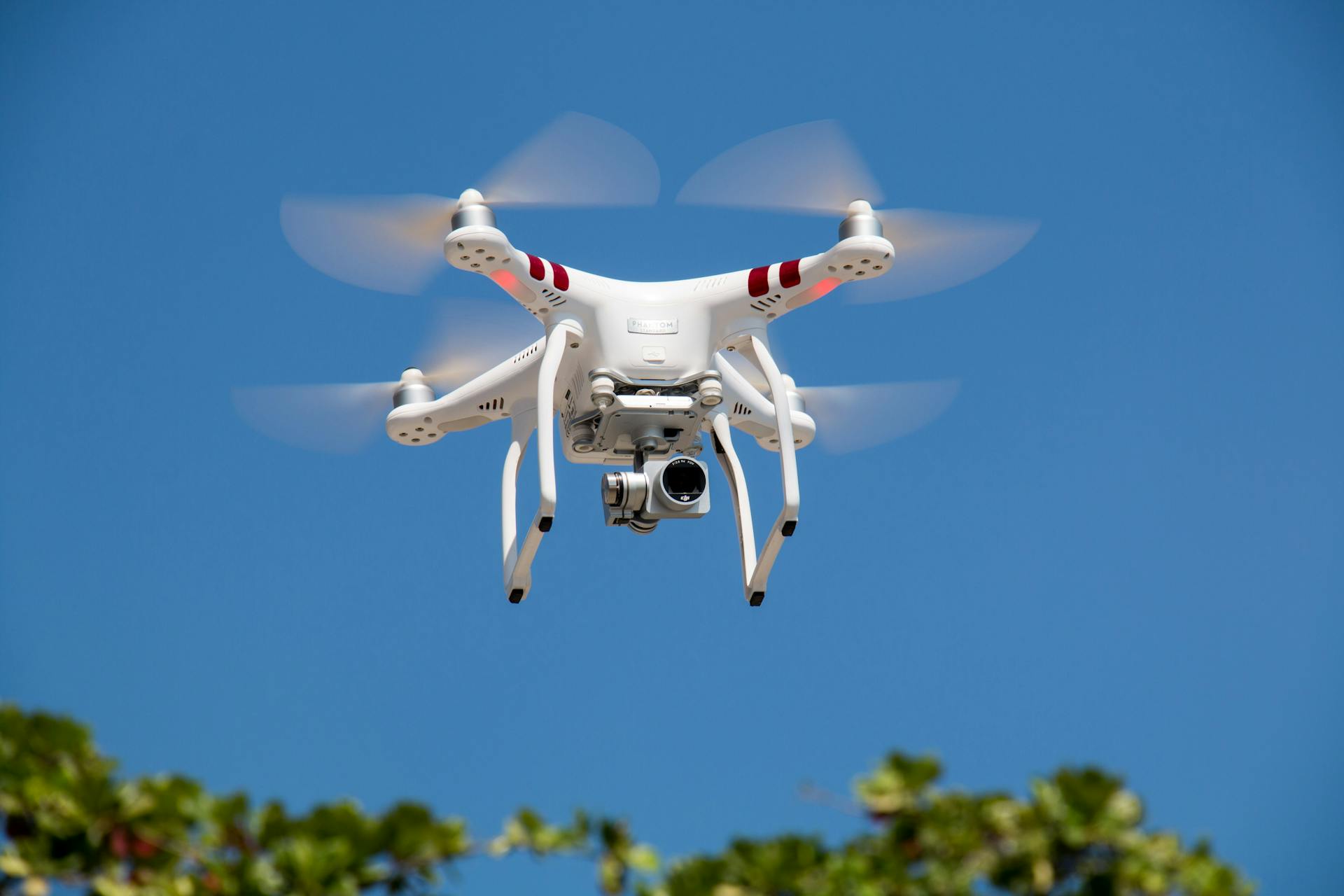
Taking a drone on a plane can be a bit of a challenge, but it's not impossible. You'll need to check the airline's policy on carrying drones, as some may have specific requirements or restrictions.
Most airlines consider drones as carry-on items, but they must be properly packed and secured in a protective case. This is to prevent damage to the drone and other passengers' belongings.
You should also be prepared to declare your drone at security checkpoints and possibly remove it from your carry-on bag for screening. Some airports may have specific procedures for handling drones, so it's a good idea to check with the airport beforehand.
If you're planning to take a drone on a plane, make sure to pack it in a hard-sided case that is specifically designed for carrying drones.
For another approach, see: Plane Drone Rc
Traveling with Drones
You can bring a drone on your travels, but not every airline or travel destination is drone-friendly.
Check with your specific airline about whether to pack your drone in your carry-on baggage or checked baggage.
In the United States, drone regulations are set by the Federal Aviation Authority (FAA), while in Canada, they're set by Transport Canada Civil Aviation (TCCA).
Make sure the drone is turned off and any switches are protected from accidental activation.
To protect your drone from damage, consider getting a special drone carrying case.
Remove propellers and store them safely, and place batteries in fireproof bags and keep them in your carry-on.
Label your drone case with contact information to prevent any misunderstandings.
You may also need to register your drone with Customs as a "Personal Effect Taken Abroad" prior to traveling, especially if you're a U.S. traveler.
Here's a quick rundown of what to pack:
- Drone in a protective case
- Propellers stored safely
- Batteries in fireproof bags and in your carry-on
- Camera lens caps
- Contact information on the drone case
Packing and Precautions
Packing your drone for a flight requires some care to ensure it arrives safely. You should remove the drone battery from the drone to prevent accidental activation. It's also a good idea to pack the drone securely, using a case that protects the gimbal and other delicate parts.
To pack lithium-ion drone batteries, you'll need to follow FAA hazardous materials regulations. This means storing them in your carry-on baggage, not in checked baggage. You can pack batteries in fireproof bags or use individual, fireproof battery pouches to keep them safe.
Here are some specific guidelines for packing LIPO batteries in your carry-on baggage:
Remember to check with your airline for their specific policies on drone batteries and cases. Some airlines, like American Airlines, have specific guidelines for battery capacity and case dimensions.
Security Check
At the security check, you'll need to separate your drone's batteries from the rest of your belongings and put them in a separate box. This is a standard procedure to ensure safety.
You should also inform the security personnel about your drone, as they will appreciate your cooperation. This can make the process smoother and less stressful for everyone involved.
Luggage containing batteries and camera equipment may be tested for explosives, but this is a routine procedure and not a cause for concern. Even if the test is positive, it's likely due to other items like asthma inhalers.
If this caught your attention, see: How Can Drones Improve Security
The security personnel will know what to do and may ask you to sign a document or re-check your luggage. But don't worry, this is just a normal part of the security process.
Here's a quick summary of what to do:
- Put drone batteries in a separate box
- Inform security personnel about your drone
- Be prepared for potential luggage testing
- Follow any additional instructions from security personnel
Travel Cases Compared
If you're planning to travel with a drone, you'll need a sturdy case to protect it. Bigger drones like the DJI Inspire 2 are too big for hand luggage, so they must be transported as checked luggage without batteries.
When it comes to hand luggage, the choice between a backpack and a suitcase doesn't make a difference. However, a backpack is often more comfortable to carry.
Here are some recommended transport options for different drone models:
Remember to mark your suitcase with a label if you're transporting a fragile drone like the DJI Inspire 2. This will help prevent damage during transit.
Packing Tips
Packing your drone for travel requires some extra care to ensure it arrives safely at your destination. Remove your drone battery from the drone to prevent accidental activation.
Discharge your drone battery to 50% or less before packing to reduce the risk of damage. Pack your drone securely, making sure the gimbal is secured in place to prevent damage during transit.
Pack your batteries in fire-safe bags, which may take up extra space but are worth it for the extra precaution. Individual, fireproof battery pouches can easily fit in a carry-on bag, but if you have multiple batteries, you may need to use fireproof Lipo battery storage bags that can count as your carry-on bag.
Know the rules and regulations regarding lithium-ion batteries, as they are restricted in checked baggage. Consider carrying a laminated sheet with the TSA requirements about LiPo batteries to show to TSA agents if needed.
Here are some essential items to pack with your drone:
- A protective drone case to keep your drone safe during transit
- Fire-safe bags for your batteries
- A laminated sheet with the TSA requirements about LiPo batteries
- A list of your drone's specifications, including battery type and capacity
By following these packing tips, you can ensure a safe and enjoyable travel experience with your drone.
How to Bring
You can bring a drone on a plane, but it's essential to follow the rules and take necessary precautions. The TSA allows drones through the checkpoint, but you should check with your airline prior to traveling for their policy.
To bring a drone on a plane, it must be turned off and precautions must be put in place to ensure that the switches are protected from accidentally being pushed into the "on" position. This is a crucial step to avoid any issues during the flight.
It's also a good idea to purchase a drone case, as it will help protect your drone and its switches during travel. If your drone is too large to fit in a carry-on case, you'll need to contact the airline to check their rules regarding such situations.
Most drones will fit in cases that are suitable for carry-on and are even required to be packed as a carry-on due to containing a lithium-ion battery. Since 2019, the Department of Transportation has placed a ban on transporting lithium-ion batteries as cargo on passenger airplanes, so the drone will need to be in the cabin with you.
Here are some airline-specific guidelines to keep in mind:
Keep in mind that these guidelines may vary depending on the airport and the TSA officer on duty. It's always a good idea to inform the TSA officer about your drone and ask if they want you to open it.
Regulations and Rules
Most U.S. airlines allow drones, but they have their own rules around how to pack them and what the battery rules are. Typically, airline rules align with the TSA, meaning that batteries must stay with you in the main cabin.
You'll need to check with your airline if you're unsure about their specific rules. Make sure you understand both your airline's and the TSA's luggage size restrictions, so your carry-on bag transporting your drone isn't too large.
Here are some key regulations to keep in mind:
Additionally, there are limits on how powerful your drone battery can be. Lithium ion, rechargeable batteries, which are common for drones, are limited to a rating of 100 watt hours (Wh) per battery.
Airline vs TSA Rules
Most U.S. airlines allow drones on planes, but they set their own rules for how to pack and transport them.
Typically, airline rules align with the TSA, requiring batteries to stay with you in the main cabin.
Delta requires you to remove lithium-ion batteries from the drone's bag before loading it in the cargo compartment.
Spare batteries must be packed in your carry-on bag or be with you onboard, as Southwest Airlines spells out.
Always check with your airline if you're unsure about their rules.
Make sure you understand both your airline's and the TSA's luggage size restrictions, so your carry-on bag transporting your drone isn't too large.
You might like: Dji - Mini 2 Se Drone with Remote Control
Wh Limits
Lithium ion batteries, commonly used in drones, are limited to a rating of 100 watt hours (Wh) per battery. This is a crucial rule to keep in mind when packing your drone for air travel.
If your drone's battery exceeds 100 Wh, you'll need to get specific airline approval before bringing it on board. This rule applies to all airlines, not just one or two.
For example, DJI's TB65 Intelligent Flight Battery, found in drones like the DJI Matrice 350 RTK, has a whopping 263 Wh rating, which means it can't be carried onto an airplane according to airline regulations.
To determine if your drone's battery meets the 100 Wh limit, check your user manual for the Wh rating. Most consumer drones will come under this limit, but enterprise and high-powered drones may not.
You're allowed to bring up to two drone batteries with a rating of 101-160 Wh, according to the TSA. Just make sure to check with your airline for their specific rules and restrictions.
Regulations and Rules
If you're planning to bring your drone on a plane, you'll need to follow some specific regulations and rules.
First and foremost, you'll need to know that most drones are powered by lithium-ion (LIPO) batteries, which are considered hazardous materials by the FAA.
You'll need to store these batteries in your carry-on baggage, as they should not be packed in checked baggage.
To determine if your drone batteries meet the requirements, you'll need to calculate their watt hours.
Here's a quick rundown of how to do this:
Remember, it's always better to err on the side of caution when it comes to traveling with a drone.
Transporting Drones
You can bring a drone on a plane, but there are some caveats to consider. The TSA website states that drones are allowed through the checkpoint, but you should check with your airline prior to traveling for their policy.
It's essential to ensure the case used to transport your drone is within the airline's allowable limits for carry-on luggage sizes. This will save you from any last-minute hassles at the airport.
To bring a drone onto an airplane, it must be turned off and precautions must be put in place to prevent accidental activation. A specialized drone case is a good investment for protecting your drone during travel.
Most drones can fit in cases suitable for carry-on, but it's crucial to check with your airline if the size of your drone exceeds the carry-on limit. Since 2019, the Department of Transportation has banned transporting lithium-ion batteries as cargo on passenger airplanes, so your drone will need to be in the cabin with you.
Here are some tips for packing your drone for a flight:
- Remove propellers and store them safely
- Place batteries in fireproof bags and keep them in your carry-on
- Use lens caps to protect the camera
- Secure loose items to prevent movement
- Label your drone case with contact information
Remember to check the specific drone regulations in your destination country, as they may vary. For example, in the United States, drone regulations are set by the Federal Aviation Authority (FAA), while in Canada, they're set by Transport Canada Civil Aviation (TCCA).
Frequently Asked Questions
Can I take my drone battery on the plane?
To travel with your drone battery, check its watt hours: if it's 100 watts or less, store it in a protective case or bag in your carry-on. For higher watt hours, follow FAA regulations for lithium-ion batteries in checked luggage.
Sources
- https://www.tomstechtime.com/airplane
- https://www.skydio.com/blog/the-ultimate-checklist-to-bringing-a-drone-on-a-plane
- https://www.thedronegirl.com/2022/12/21/drone-on-a-plane/
- https://uavcoach.com/bring-drone-on-plane/
- https://www.pelican.com/us/en/discover/pelican-flyer/post/can-you-bring-a-drone-on-a-plane/
Featured Images: pexels.com


